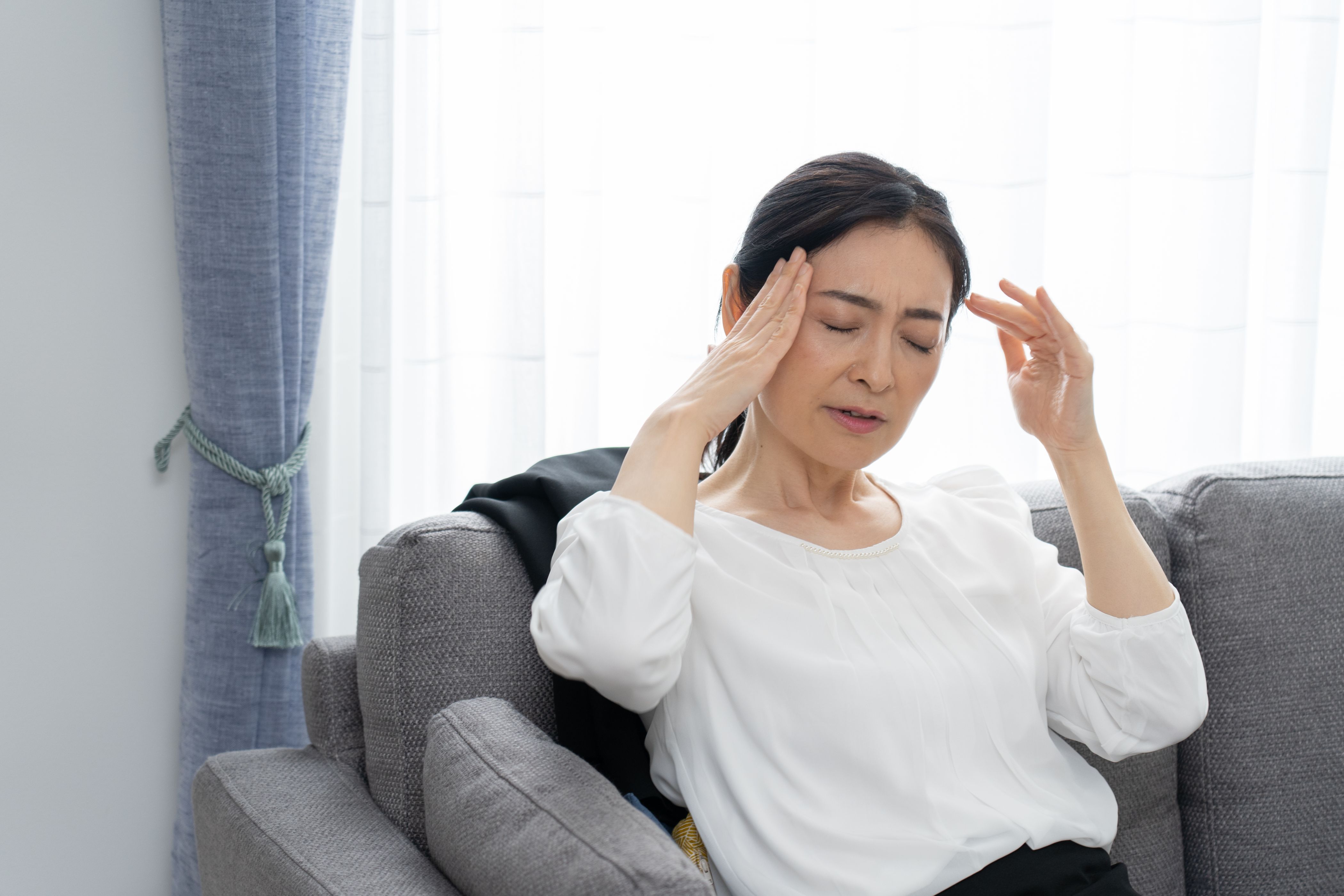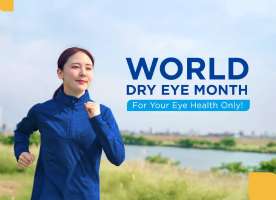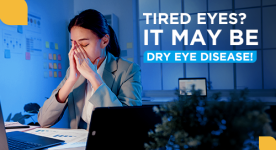Is Dry Eye Common During Menopause?
Dry eye disease (DED) is more common in women, especially in the menopausal and postmenopausal stages.1 Remained untreated, DED can progress and significantly reduce an individual’s quality of life. In this article, we will learn about menopause, why menopause puts women at higher risk for DED, and tips to help you relieve DED symptoms.
Menopause
Menopause is defined as the cessation of a woman's period for 12 months in a row. The menopausal transition usually begins between the ages of 45 and 55 and lasts 7 to 14 years. The duration varies based on genetic as well as lifestyle factors. Sometimes, menopause can occur earlier naturally or because of surgery (removing ovaries or uterus), cancer treatments, or genetic reasons.2,3
Menopause is a physical condition in women; it is not a disease or disorder. Women may or may not experience perimenopausal symptoms, including:2–4
 Irregular periods
Irregular periods
Period frequency is shorter, period last longer, heavy bleeding
 Hot flashes
Hot flashes
A sudden heat feeling, flushed face and neck, followed by heavy sweating and cold shivering. The symptoms are common and can last many years after menopause. Hot flashes often last within 30 seconds to 10 minutes and happen a few times an hour, a day, or a week.
 Vaginal and bladder problems
Vaginal and bladder problems
Lower estrogen levels decrease lubrication and elasticity of vaginal tissues. It also makes you more vulnerable to urinary and vaginal infections. Your bladder also loses control, also known as incontinence, leading to a sudden urge to urinate, urine leaking during exercise, sneezing, or laughing.
 Sleep problems
Sleep problems
Hot flashes and night sweats may be the cause of trouble sleeping.
 Mood changes
Mood changes
Women may be more irritable and at more risk of depression.
 Loss of bone
Loss of bone
Lower estrogen increases the risk of osteoporosis, causing fragile bones.
 Changing cholesterol levels
Changing cholesterol levels
The “bad” cholesterol (low-density lipoprotein, LDL) increases, and the “good” cholesterol (high-density lipoprotein, HDL) decreases, leading to a higher risk of heart disease.
After menopause, women enter postmenopause, which inflates their risks of heart disease and osteoporosis. Apart from the abovementioned symptoms, many studies showed that DED is common in menopausal and postmenopausal women.5–7 Hence, eye care plays an essential role for women in menopause and postmenopause.
Why is menopause a risk factor for DED?

Menopausal women experience a lot of changes in their bodies due to the low levels of sex hormones, especially estrogen. Although the reasons for menopause causing DED has not been well established, many studies have pointed out the relationship between sex hormones and dry eyes.8,9 Estrogen regulates the formation of the lipid layer of the tear film, which is responsible for controlling tear evaporation.10,11 Deficiency of estrogen may raise the risk of tear film breakup, leading to irritation and excessive tear evaporation. Moreover, some studies also suggested that estrogen may possess anti-inflammatory effects.8 Thus, a lower level of estrogen may promote inflammation, which increases the risk of dry eyes.
Tips to relieve dry eyes in menopause
Here are some tips to ease symptoms of DED in menopause:12



Adequate sleep may help improve the symptoms of DED because many studies show that sleep disorders may lead to reduced tear secretion and stability. You can sleep better by avoiding electronic devices before bedtime, avoiding caffeine in the afternoon or evening, regulating the room humidity and temperature, and moisturizing eyes at night (using eyedrops, gels, ointments, etc.).

Artificial tears contain ingredients that help protect the epithelial cells on the eye surface and promote the recovery of the damaged barriers. They relieve the symptoms and form a temporary barrier to protect your eyes. Most of these artificial tears are over-the-counter, but it is better to consult your doctor before using them.

- Matossian, C.; McDonald, M.; Donaldson, K. E.; Nichols, K. K.; MacIver, S.; Gupta, P. K. Dry Eye Disease: Consideration for Women’s Health. J. Womens Health 2019, 28 (4), 502–514. https://doi.org/10.1089/jwh.2018.7041.
- Menopause. nhs.uk. https://www.nhs.uk/conditions/menopause/ (accessed 2022-11-07).
- What Is Menopause?. National Institute on Aging. https://www.nia.nih.gov/health/what-menopause (accessed 2022-11-07).
- Perimenopause - Symptoms and causes. Mayo Clinic. https://www.mayoclinic.org/diseases-conditions/perimenopause/symptoms-causes/syc-20354666 (accessed 2022-11-07).
- P Maurya, R.; P Singh, V.; Chaudhary, S.; Roy, M.; Srivastav, T. Prevalence of Severe Dry Eye Disease in Postmenopausal Women in North India: A Teaching Hospital Study. Indian J. Obstet. Gynecol. Res. 2019, 6 (1), 94–96. https://doi.org/10.18231/2394-2754.2019.0021.
- Garcia-Alfaro, P.; Garcia, S.; Rodriguez, I.; Vergés, C. Dry Eye Disease Symptoms and Quality of Life in Perimenopausal and Postmenopausal Women. Climacteric 2021, 24 (3), 261–266. https://doi.org/10.1080/13697137.2020.1849087.
- Kumar, G. V.; . A.; Praneetha, G.; Pandharpurkar, A.; Prasad, B.; Pavani, G.; Vasavi, T.; Naik, A. A Study on Prevalence of Dry Eyes among Menopausal Women Attending a Tertiary Care Centre in Hyderabad, Telangana. Int. J. Community Med. Public Health 2018, 6 (1), 423. https://doi.org/10.18203/2394-6040.ijcmph20185266.
- Truong, S.; Cole, N.; Stapleton, F.; Golebiowski, B. Sex Hormones and the Dry Eye. Clin. Exp. Optom. 2014, 97 (4), 324–336. https://doi.org/10.1111/cxo.12147.
- Peck, T.; Olsakovsky, L.; Aggarwal, S. Dry Eye Syndrome in Menopause and Perimenopausal Age Group. J. -Life Health 2017, 8 (2), 51. https://doi.org/10.4103/jmh.JMH_41_17.
- Dartt, D. A.; Willcox, M. D. P. Complexity of the Tear Film: Importance in Homeostasis and Dysfunction during Disease. Exp. Eye Res. 2013, 117, 1–3. https://doi.org/10.1016/j.exer.2013.10.008.
- Song, X.; Zhao, P.; Wang, G.; Zhao, X. The Effects of Estrogen and Androgen on Tear Secretion and Matrix Metalloproteinase-2 Expression in Lacrimal Glands of Ovariectomized Rats. Investig. Opthalmology Vis. Sci. 2014, 55 (2), 745. https://doi.org/10.1167/iovs.12-10457.
- Lurati, A. R. Menopause and Dry Eye Syndrome. Nurs. Womens Health 2019, 23 (1), 71–78. https://doi.org/10.1016/j.nwh.2018.11.001.
- Deinema, L. A.; Vingrys, A. J.; Wong, C. Y.; Jackson, D. C.; Chinnery, H. R.; Downie, L. E. A Randomized, Double-Masked, Placebo-Controlled Clinical Trial of Two Forms of Omega-3 Supplements for Treating Dry Eye Disease. Ophthalmology 2017, 124 (1), 43–52. https://doi.org/10.1016/j.ophtha.2016.09.023.
- Office of Dietary Supplements - Omega-3 Fatty Acids. https://ods.od.nih.gov/factsheets/Omega3FattyAcids-Consumer/ (accessed 2022-11-08).
- Kayal, A. The Physiology of Tear Film. In Dry Eye Syndrome - Modern Diagnostic Techniques and Advanced Treatments; M. Ferreri, F., Ed.; IntechOpen, 2022. https://doi.org/10.5772/intechopen.98945.
- How much water do you need to stay healthy?. Mayo Clinic. https://www.mayoclinic.org/healthy-lifestyle/nutrition-and-healthy-eating/in-depth/water/art-20044256 (accessed 2022-11-12).
Five‐item Dry Eye Questionnaire (DEQ-5).
관련 게시물
Five‐item Dry Eye Questionnaire (DEQ-5).
Five‐item Dry Eye Questionnaire (DEQ-5).









